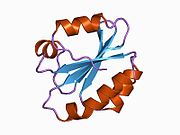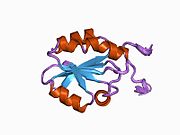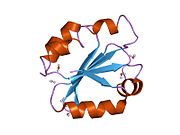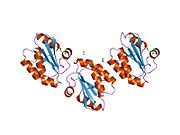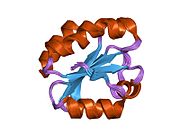An Error has occurred retrieving Wikidata item for infobox Thioredoxin is a class of small redox proteins known to be present in all organisms. It plays a role in many important biological processes, including redox signaling. In humans, thioredoxins are encoded by TXN and TXN2 genes. [1] [2] Loss-of-function mutation of either of the two human thioredoxin genes is lethal at the four-cell stage of the developing embryo. Although not entirely understood, thioredoxin plays a central role in humans and is increasingly linked to medicine through their response to reactive oxygen species (ROS). In plants, thioredoxins regulate a spectrum of critical functions, ranging from photosynthesis to growth, flowering and the development and germination of seeds. It has also recently been found to play a role in cell-to-cell communication. [3]
Function
Thioredoxins are proteins that act as antioxidants by facilitating the reduction of other proteins by cysteine thiol-disulfide exchange. Thioredoxins are found in nearly all known organisms and are essential for life in mammals. [4] [5]
Thioredoxin is a 12-kD oxidoreductase enzyme containing a dithiol-disulfide active site. It is ubiquitous and found in many organisms from plants and bacteria to mammals. Multiple in vitro substrates for thioredoxin have been identified, including ribonuclease, choriogonadotropins, coagulation factors, glucocorticoid receptor, and insulin. Reduction of insulin is classically used as an activity test. [6]
Thioredoxins are characterized at the level of their amino acid sequence by the presence of two vicinal cysteines in a CXXC motif. These two cysteines are the key to the ability of thioredoxin to reduce other proteins. Thioredoxin proteins also have a characteristic tertiary structure termed the thioredoxin fold.
The thioredoxins are kept in the reduced state by the flavoenzyme thioredoxin reductase, in a NADPH-dependent reaction. [7] Thioredoxins act as electron donors to peroxidases and ribonucleotide reductase. [8] The related glutaredoxins share many of the functions of thioredoxins, but are reduced by glutathione rather than a specific reductase.
The benefit of thioredoxins to reduce oxidative stress is shown by transgenic mice that overexpress thioredoxin, are more resistant to inflammation, and live 35% longer [9] — supporting the free radical theory of aging. However, the controls of this study were short lived, which may have contributed to the apparent increase in longevity. [10]
Plants have an unusually complex complement of Trxs composed of six well-defined types (Trxs f, m, x, y, h, and o) that reside in different cell compartments and function in an array of processes. In 2010 it was discovered for the first time that thioredoxin proteins are able to move from cell to cell, representing a novel form of cellular communication in plants. [3]
Mechanism of action
The primary function of Thioredoxin (Trx) is the reduction of oxidized cysteine residues and the cleavage of disulfide bonds. [11] For Trx1, this process begins by attack of Cys32, one of the residues conserved in the thioredoxin CXXC motif, onto the oxidized group of the substrate. [12] Almost immediately after this event Cys35, the other conserved Cys residue in Trx1, forms a disulfide bond with Cys32, thereby transferring 2 electrons to the substrate which is now in its reduced form. Oxidized Trx1 is then reduced by thioredoxin reductase, which in turn is reduced by NADPH as described above. [12]
Interactions
Thioredoxin has been shown to interact with:
- ASK1, [13] [14] [15]
- Collagen, type I, alpha 1, [16]
- Glucocorticoid receptor, [17]
- SENP1, [18] and
- TXNIP. [19]
- NF-κB – by reducing a disulfide bond in NF-κB, Trx1 promotes binding of this transcription factor to DNA. [20]
- AP1 via Ref1 – Trx1 indirectly increases the DNA-binding activity of activator protein 1 (AP1) by reducing the DNA repair enzyme redox factor 1 (Ref-1), which in turn reduces AP1 in an example of a redox regulation cascade. [21]
- AMPK – AMPK function in cardiomyocytes is preserved during oxidative stress due to an interaction between AMPK and Trx1. By forming a disulfide bridge between the two proteins, Trx1 prevents the formation and aggregation of oxidized AMPK, thereby allowing AMPK to function normally and participate in signaling cascades. [22]
Effect on cardiac hypertrophy
Trx1 has been shown to downregulate cardiac hypertrophy, the thickening of the walls of the lower heart chambers, by interactions with several different targets. Trx1 upregulates the transcriptional activity of nuclear respiratory factors 1 and 2 ( NRF1 and NRF2) and stimulates the expression of peroxisome proliferator-activated receptor γ coactivator 1-α ( PGC-1α). [23] [24] Furthermore, Trx1 reduces two cysteine residues in histone deacetylase 4 ( HDAC4), which allows HDAC4 to be imported from the cytosol, where the oxidized form resides, [25] into the nucleus. [26] Once in the nucleus, reduced HDAC4 downregulates the activity of transcription factors such as NFAT that mediate cardiac hypertrophy. [12] Trx 1 also controls microRNA levels in the heart and has been found to inhibit cardiac hypertrophy by upregulating miR-98/ let-7. [27]
See also
- RuBisCO - enzyme activity regulated by thioredoxin
- Peroxiredoxin - enzyme activity regulated by thioredoxin
- Thioredoxin fold
References
- ^ Wollman EE, d'Auriol L, Rimsky L, Shaw A, Jacquot JP, Wingfield P, Graber P, Dessarps F, Robin P, Galibert F (October 1988). "Cloning and expression of a cDNA for human thioredoxin". J. Biol. Chem. 263 (30): 15506–12. PMID 3170595.
- ^ "Entrez Gene: TXN2 thioredoxin 2".
- ^ a b Meng L, Wong JH, Feldman LJ, Lemaux PG, Buchanan BB (2010). "A membrane-associated thioredoxin required for plant growth moves from cell to cell, suggestive of a role in intercellular communication". Proceedings of the National Academy of Sciences of the USA. 107 (8): 3900–5. doi: 10.1073/pnas.0913759107. PMC 2840455. PMID 20133584.
- ^ Holmgren A (1989). "Thioredoxin and glutaredoxin systems" (PDF). J Biol Chem. 264 (24): 13963–6. PMID 2668278.
- ^ Nordberg J, Arnér ES (2001). "Reactive oxygen species, antioxidants, and the mammalian thioredoxin system". Free Radic Biol Med. 31 (11): 1287–312. doi: 10.1016/S0891-5849(01)00724-9. PMID 11728801.
- ^ "Entrez Gene: TXN thioredoxin".
- ^ Mustacich D, Powis G (February 2000). "Thioredoxin reductase". Biochem J. 346 (Pt 1): 1–8. doi: 10.1042/0264-6021:3460001. PMC 1220815. PMID 10657232.
- ^ Arnér ES, Holmgren A (2000). "Physiological functions of thioredoxin and thioredoxin reductase". Eur J Biochem. 267 (20): 6102–9. doi: 10.1046/j.1432-1327.2000.01701.x. PMID 11012661.
- ^ Yoshida T, Nakamura H, Masutani H, Yodoi J (2005). "The involvement of thioredoxin and thioredoxin binding protein-2 on cellular proliferation and aging process". Annals of the New York Academy of Sciences. 1055: 1–12. doi: 10.1196/annals.1323.002. PMID 16387713.
- ^ Muller, F.L., Lustgarten, M.S., Jang, Y., Richardson, A. & Van Remmen, H. Trends in oxidative aging theories. Free Radic Biol Med 43, 477-503 (2007).
- ^ "Redox Regulation of Cellular Activation". Annual Review of Immunology. 15 (1): 351–369. 1997-01-01. doi: 10.1146/annurev.immunol.15.1.351. PMID 9143692.
- ^ a b c Nagarajan, Narayani; Oka, Shinichi; Sadoshima, Junichi. "Modulation of signaling mechanisms in the heart by thioredoxin 1". Free Radical Biology and Medicine. doi: 10.1016/j.freeradbiomed.2016.12.020.
- ^ Liu Y, Min W (June 2002). "Thioredoxin promotes ASK1 ubiquitination and degradation to inhibit ASK1-mediated apoptosis in a redox activity-independent manner". Circ. Res. 90 (12): 1259–66. doi: 10.1161/01.res.0000022160.64355.62. PMID 12089063.
- ^ Morita K, Saitoh M, Tobiume K, Matsuura H, Enomoto S, Nishitoh H, Ichijo H (November 2001). "Negative feedback regulation of ASK1 by protein phosphatase 5 (PP5) in response to oxidative stress". EMBO J. 20 (21): 6028–36. doi: 10.1093/emboj/20.21.6028. PMC 125685. PMID 11689443.
- ^ Saitoh M, Nishitoh H, Fujii M, Takeda K, Tobiume K, Sawada Y, Kawabata M, Miyazono K, Ichijo H (May 1998). "Mammalian thioredoxin is a direct inhibitor of apoptosis signal-regulating kinase (ASK) 1". EMBO J. 17 (9): 2596–606. doi: 10.1093/emboj/17.9.2596. PMC 1170601. PMID 9564042.
- ^ Matsumoto K, Masutani H, Nishiyama A, Hashimoto S, Gon Y, Horie T, Yodoi J (July 2002). "C-propeptide region of human pro alpha 1 type 1 collagen interacts with thioredoxin". Biochem. Biophys. Res. Commun. 295 (3): 663–7. doi: 10.1016/s0006-291x(02)00727-1. PMID 12099690.
-
^ Makino Y, Yoshikawa N, Okamoto K, Hirota K, Yodoi J, Makino I, Tanaka H (January 1999). "Direct association with thioredoxin allows redox regulation of glucocorticoid receptor function". J. Biol. Chem. 274 (5): 3182–8.
doi:
10.1074/jbc.274.5.3182.
PMID
9915858.
{{ cite journal}}: CS1 maint: unflagged free DOI ( link) - ^ Li X, Luo Y, Yu L, Lin Y, Luo D, Zhang H, He Y, Kim YO, Kim Y, Tang S, Min W (April 2008). "SENP1 mediates TNF-induced desumoylation and cytoplasmic translocation of HIPK1 to enhance ASK1-dependent apoptosis". Cell Death Differ. 15 (4): 739–50. doi: 10.1038/sj.cdd.4402303. PMID 18219322.
-
^ Nishiyama A, Matsui M, Iwata S, Hirota K, Masutani H, Nakamura H, Takagi Y, Sono H, Gon Y, Yodoi J (July 1999). "Identification of thioredoxin-binding protein-2/vitamin D(3) up-regulated protein 1 as a negative regulator of thioredoxin function and expression". J. Biol. Chem. 274 (31): 21645–50.
doi:
10.1074/jbc.274.31.21645.
PMID
10419473.
{{ cite journal}}: CS1 maint: unflagged free DOI ( link) -
^ Matthews, J R; Wakasugi, N; Virelizier, J L; Yodoi, J; Hay, R T (1992-08-11).
"Thioredoxin regulates the DNA binding activity of NF-kappa B by reduction of a disulphide bond involving cysteine 62". Nucleic Acids Research. 20 (15): 3821–3830.
ISSN
0305-1048.
PMC
334054.
PMID
1508666.
{{ cite journal}}: CS1 maint: PMC format ( link) -
^ Hirota, Kiichi; Matsui, Minoru; Iwata, Satoshi; Nishiyama, Akira; Mori, Kenjiro; Yodoi, Junji (1997-04-15).
"AP-1 transcriptional activity is regulated by a direct association between thioredoxin and Ref-1". Proceedings of the National Academy of Sciences. 94 (8): 3633–3638.
ISSN
0027-8424.
PMC
20492.
PMID
9108029.
{{ cite journal}}: CS1 maint: PMC format ( link) -
^ Shao, Dan; Oka, Shin-Ichi; Liu, Tong; Zhai, Peiyong; Ago, Tetsuro; Sciarretta, Sebastiano; Li, Hong; Sadoshima, Junichi (2014-02-04).
"A redox-dependent mechanism for regulation of AMPK activation by Thioredoxin1 during energy starvation". Cell Metabolism. 19 (2): 232–245.
doi:
10.1016/j.cmet.2013.12.013.
ISSN
1932-7420.
PMC
3937768.
PMID
24506865.
{{ cite journal}}: CS1 maint: PMC format ( link) - ^ Ago, Tetsuro; Yeh, Ijen; Yamamoto, Mitsutaka; Schinke-Braun, Martina; Brown, Jeffrey A.; Tian, Bin; Sadoshima, Junichi. "Thioredoxin1 Upregulates Mitochondrial Proteins Related to Oxidative Phosphorylation and TCA Cycle in the Heart". Antioxidants & Redox Signaling. 8 (9–10): 1635–1650. doi: 10.1089/ars.2006.8.1635.
-
^ Yamamoto, Mitsutaka; Yang, Guiping; Hong, Chull; Liu, Jing; Holle, Eric; Yu, Xianzhong; Wagner, Thomas; Vatner, Stephen F.; Sadoshima, Junichi (2003-11-01).
"Inhibition of endogenous thioredoxin in the heart increases oxidative stress and cardiac hypertrophy". The Journal of Clinical Investigation. 112 (9): 1395–1406.
doi:
10.1172/JCI17700.
ISSN
0021-9738.
PMC
228400.
PMID
14597765.
{{ cite journal}}: CS1 maint: PMC format ( link) -
^ Matsushima, Shouji; Kuroda, Junya; Ago, Tetsuro; Zhai, Peiyong; Park, Ji Yeon; Xie, Lai-Hua; Tian, Bin; Sadoshima, Junichi (2013-02-15).
"Increased Oxidative Stress in the Nucleus Caused by Nox4 Mediates Oxidation of HDAC4 and Cardiac HypertrophyNovelty and Significance". Circulation Research. 112 (4): 651–663.
doi:
10.1161/CIRCRESAHA.112.279760.
ISSN
0009-7330.
PMC
3574183.
PMID
23271793.
{{ cite journal}}: CS1 maint: PMC format ( link) - ^ Ago, Tetsuro; Liu, Tong; Zhai, Peiyong; Chen, Wei; Li, Hong; Molkentin, Jeffery D.; Vatner, Stephen F.; Sadoshima, Junichi (2008-06-13). "A redox-dependent pathway for regulating class II HDACs and cardiac hypertrophy". Cell. 133 (6): 978–993. doi: 10.1016/j.cell.2008.04.041. ISSN 1097-4172. PMID 18555775.
-
^ Yang, Yanfei; Ago, Tetsuro; Zhai, Peiyong; Abdellatif, Maha; Sadoshima, Junichi (2011-02-04).
"Thioredoxin 1 Negatively Regulates Angiotensin II–Induced Cardiac Hypertrophy Through Upregulation of miR-98/let-7Novelty and Significance". Circulation Research. 108 (3): 305–313.
doi:
10.1161/CIRCRESAHA.110.228437.
ISSN
0009-7330.
PMC
3249645.
PMID
21183740.
{{ cite journal}}: CS1 maint: PMC format ( link)
Further reading
- Arnér ES, Holmgren A (2000). "Physiological functions of thioredoxin and thioredoxin reductase". Eur. J. Biochem. 267 (20): 6102–9. doi: 10.1046/j.1432-1327.2000.01701.x. PMID 11012661.
- Nishinaka Y, Masutani H, Nakamura H, Yodoi J (2002). "Regulatory roles of thioredoxin in oxidative stress-induced cellular responses". Redox Rep. 6 (5): 289–95. doi: 10.1179/135100001101536427. PMID 11778846.
- Ago T, Sadoshima J (2007). "Thioredoxin and Ventricular Remodeling". J. Mol. Cell. Cardiol. 41 (5): 762–73. doi: 10.1016/j.yjmcc.2006.08.006. PMC 1852508. PMID 17007870.
- Tonissen KF, Wells JR (1991). "Isolation and characterization of human thioredoxin-encoding genes". Gene. 102 (2): 221–8. doi: 10.1016/0378-1119(91)90081-L. PMID 1874447.
- Martin H, Dean M (1991). "Identification of a thioredoxin-related protein associated with plasma membranes". Biochem. Biophys. Res. Commun. 175 (1): 123–8. doi: 10.1016/S0006-291X(05)81209-4. PMID 1998498.
- Forman-Kay JD, Clore GM, Wingfield PT, Gronenborn AM (1991). "High-resolution three-dimensional structure of reduced recombinant human thioredoxin in solution". Biochemistry. 30 (10): 2685–98. doi: 10.1021/bi00224a017. PMID 2001356.
- Jacquot JP, de Lamotte F, Fontecave M, Schürmann P, Decottignies P, Miginiac-Maslow M, Wollman E (1991). "Human thioredoxin reactivity-structure/function relationship". Biochem. Biophys. Res. Commun. 173 (3): 1375–81. doi: 10.1016/S0006-291X(05)80940-4. PMID 2176490.
- Forman-Kay JD, Clore GM, Driscoll PC, Wingfield P, Richards FM, Gronenborn AM (1990). "A proton nuclear magnetic resonance assignment and secondary structure determination of recombinant human thioredoxin". Biochemistry. 28 (17): 7088–97. doi: 10.1021/bi00443a045. PMID 2684271.
- Tagaya Y, Maeda Y, Mitsui A, Kondo N, Matsui H, Hamuro J, Brown N, Arai K, Yokota T, Wakasugi H (1989). "ATL-derived factor (ADF), an IL-2 receptor/Tac inducer homologous to thioredoxin; possible involvement of dithiol-reduction in the IL-2 receptor induction". EMBO J. 8 (3): 757–64. PMC 400872. PMID 2785919.
- Wollman EE, d'Auriol L, Rimsky L, Shaw A, Jacquot JP, Wingfield P, Graber P, Dessarps F, Robin P, Galibert F (1988). "Cloning and expression of a cDNA for human thioredoxin". J. Biol. Chem. 263 (30): 15506–12. PMID 3170595.
- Heppell-Parton A, Cahn A, Bench A, Lowe N, Lehrach H, Zehetner G, Rabbitts P (1995). "Thioredoxin, a mediator of growth inhibition, maps to 9q31". Genomics. 26 (2): 379–81. doi: 10.1016/0888-7543(95)80223-9. PMID 7601465.
- Qin J, Clore GM, Kennedy WM, Huth JR, Gronenborn AM (1995). "Solution structure of human thioredoxin in a mixed disulfide intermediate complex with its target peptide from the transcription factor NF kappa B". Structure. 3 (3): 289–97. doi: 10.1016/S0969-2126(01)00159-9. PMID 7788295.
- Kato S, Sekine S, Oh SW, Kim NS, Umezawa Y, Abe N, Yokoyama-Kobayashi M, Aoki T (1995). "Construction of a human full-length cDNA bank". Gene. 150 (2): 243–50. doi: 10.1016/0378-1119(94)90433-2. PMID 7821789.
- Qin J, Clore GM, Gronenborn AM (1994). "The high-resolution three-dimensional solution structures of the oxidized and reduced states of human thioredoxin". Structure. 2 (6): 503–22. doi: 10.1016/S0969-2126(00)00051-4. PMID 7922028.
- Gasdaska PY, Oblong JE, Cotgreave IA, Powis G (1994). "The predicted amino acid sequence of human thioredoxin is identical to that of the autocrine growth factor human adult T-cell derived factor (ADF): thioredoxin mRNA is elevated in some human tumors". Biochim. Biophys. Acta. 1218 (3): 292–6. doi: 10.1016/0167-4781(94)90180-5. PMID 8049254.
- Qin J, Clore GM, Kennedy WP, Kuszewski J, Gronenborn AM (1996). "The solution structure of human thioredoxin complexed with its target from Ref-1 reveals peptide chain reversal". Structure. 4 (5): 613–20. doi: 10.1016/S0969-2126(96)00065-2. PMID 8736558.
- Weichsel A, Gasdaska JR, Powis G, Montfort WR (1996). "Crystal structures of reduced, oxidized, and mutated human thioredoxins: evidence for a regulatory homodimer". Structure. 4 (6): 735–51. doi: 10.1016/S0969-2126(96)00079-2. PMID 8805557.
- Andersen JF, Sanders DA, Gasdaska JR, Weichsel A, Powis G, Montfort WR (1997). "Human thioredoxin homodimers: regulation by pH, role of aspartate 60, and crystal structure of the aspartate 60 --> asparagine mutant". Biochemistry. 36 (46): 13979–88. doi: 10.1021/bi971004s. PMID 9369469.
- Maruyama T, Kitaoka Y, Sachi Y, Nakanoin K, Hirota K, Shiozawa T, Yoshimura Y, Fujii S, Yodoi J (1998). "Thioredoxin expression in the human endometrium during the menstrual cycle". Mol. Hum. Reprod. 3 (11): 989–93. doi: 10.1093/molehr/3.11.989. PMID 9433926.
- Sahlin L, Stjernholm Y, Holmgren A, Ekman G, Eriksson H (1998). "The expression of thioredoxin mRNA is increased in the human cervix during pregnancy". Mol. Hum. Reprod. 3 (12): 1113–7. doi: 10.1093/molehr/3.12.1113. PMID 9464857.
- Maeda K, Hägglund P, Finnie C, Svensson B, Henriksen A (2006). "Structural basis for target protein recognition by the protein disulfide reductase thioredoxin". Structure. 14 (11): 1701–10. doi: 10.1016/j.str.2006.09.012. PMID 17098195.
External links
- Thioredoxin at the U.S. National Library of Medicine Medical Subject Headings (MeSH)

